 |
||||||
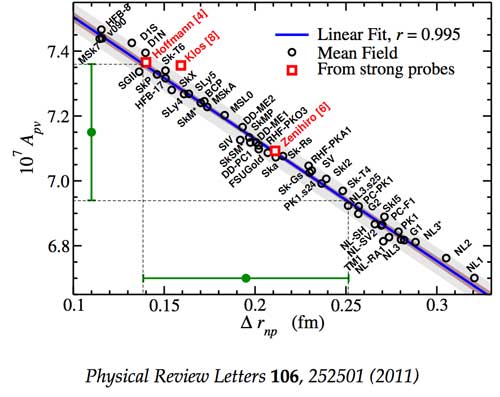 Weak Elastic Scattering with Nuclei (INT-19-73W)
Weak Elastic Scattering with Nuclei (INT-19-73W)(INT Workshop March 4 - 8, 2019)
Reported by P. Barbeau, K. Patton, S. Riordan
Weak elastic scattering of leptons from nuclei is a powerful channel to expose important nuclear matter properties and to study fundamental interactions providing a broad reach into several physics disciplines. In particular, the weak neutral current coupling is much larger for the neutron than the proton, providing a clear opportunity to obtain precise information on the ground state neutron distributions. Read more...
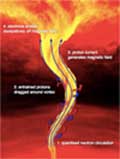 Quantum Turbulence: Cold Atoms, Heavy Ions, and Neutron Stars (INT-19-1a)
Quantum Turbulence: Cold Atoms, Heavy Ions, and Neutron Stars (INT-19-1a)(INT Program March 18 - April 19, 2019)
Reported by A. Bulgac, M. Forbes, B. Haskell
Turbulence phenomena are characterized by cascades and inverse cascades of energy through different length scales. Quantum superfluids, despite being dissipationless, also exhibit turbulent phenomena which is typically characterized by the creation and dynamics of topological defects such as superfluid vortices and vortex rings. Read more...
 Origins of Correlations in High Energy Collisions (INT-19-1b)
Origins of Correlations in High Energy Collisions (INT-19-1b)(INT Program April 29 - May 24, 2019)
Reported by A. Dumitru, C. Loizides, B. Schenke, S. Schlichting
The program "Origins of Correlations in High Energy Collisions" focused on the physical origins of multi-particle correlations in high energy collisions of hadrons and nuclei, as well as in electron-hadron/nucleus collisions. Strong focus lay on the understanding of 2- and 4- particle correlations in collisions of protons with heavy nuclei (and other protons) at RHIC and LHC, as well as in collisions of other very light nuclei with heavy nuclei at RHIC. Read more...
 Nuclear Structure at the Crossroads (INT-19-2a)
Nuclear Structure at the Crossroads (INT-19-2a)(INT Program July 1 - August 2, 2019)
Reported by R.J. Furnstahl, H-W. Hammer, A. Schwenk
Effective Field Theories (EFTs) applied to nuclei and nuclear matter have had many phenomenological successes. In particular, nuclear interactions derived from chiral EFT and advances in nuclear many-body techniques have enabled rapid progress in ab initio nuclear structure calculations up to mass numbers A ~ 100. Read more...
 Heavy-Quark Physics and Fundamental Symmetries (INT-19-2b)
Heavy-Quark Physics and Fundamental Symmetries (INT-19-2b)(INT Program August 12 - September 6, 2019)
Reported by A. Bharucha, A. Crivellin, W. Detmold, M. Hoferichter
While the LHC has not directly observed any new particles, in the last years several experiments have found strong indications for New-Physics contributions in semi-leptonic B-meson decays. However, in many cases, the significance of the observation crucially depends on hadronic form factors, with profound consequences for the interpretation of the experimental measurements and their impact on models of physics beyond the Standard Model (BSM). Read more...
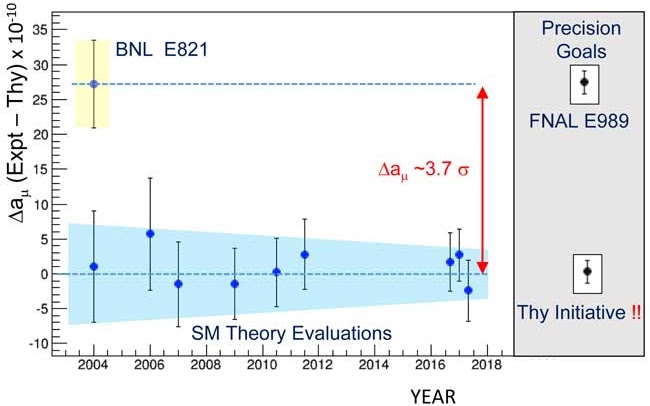 Hadronic contributions to (g-2)μ (INT-19-74W)
Hadronic contributions to (g-2)μ (INT-19-74W)(INT Program September 9 - 13, 2019)
Reported by A. El-Khadra, D. Hertzog, M. Hoferichter
The deviation between measurement and Standard-Model (SM) prediction of the anomalous magnetic moment of the muon is one of the few current persistent hints for physics beyond the SM. Because the muon g-2 arises from quantum-mechanical loop contributions in the SM, it is sensitive to virtual effects
of new particles, and places important constraints on SM extensions. Read more...
2018
 Multi-Hadron Systems from Lattice QCD (INT-18-70W)
Multi-Hadron Systems from Lattice QCD (INT-18-70W)(INT Workshop February 5 - 9, 2018)
Reported by R. Briceño, M. Hansen, S. Sharpe, D. Wilson
Reported on March 7, 2018
Recent years have seen dramatic progress in the determination of multi-hadron observables using lattice QCD (LQCD). Examples include the determination of scattering amplitudes involving multiple two-particle channels (e.g. the scalar-isocalar sector involving two pion and kaon-antikaon channels), and the first study of a nuclear fusion reaction. Read more...
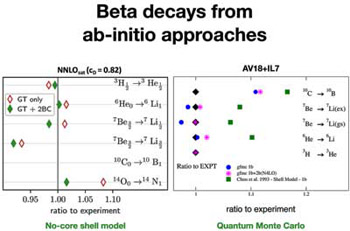 Nuclear ab initio Theories and Neutrino Physics (INT-18-1a)
Nuclear ab initio Theories and Neutrino Physics (INT-18-1a)(INT Program February 26 - March 30, 2018)
Reported by C. Barbieri, O. Benhar, A. Galindo-Uribarri, A. Lovato, J. Menéndez
Reported on July 2, 2018
Ab initio nuclear theory have reached the degree of maturity to describe the structure and electroweak interactions of atomic nuclei. This paves the way to quantitative predictions on the interaction of neutrinos with nuclei, which span broad energy and momentum regimes. This is a required input for a quantitative study of fundamental symmetries and astrophysical processes. Read more...
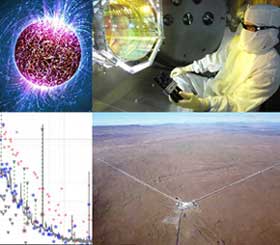 Astro-Solids, Dense Matter, and Gravitational Waves (INT-18-71W)
Astro-Solids, Dense Matter, and Gravitational Waves (INT-18-71W)(INT Workshop April 16 - 20, 2018)
Reported by N. Andersson, C. Horowitz, M. Alessandra Papa
Reported on May 7, 2018
At the dawn of gravitational-wave astronomy, there is renewed focus on the range of astrophysical sources and the information that can be extracted from observations. This one-week workshop motivated new theoretical work on continuous gravitational-wave sources and improved the communication between nuclear physicists, gravitational-wave experts, and astrophysicists working on dense matter and compact objects. Read more...
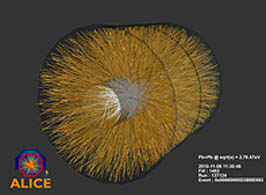 Multi-Scale Problems Using Effective Field Theories (INT-18-1b)
Multi-Scale Problems Using Effective Field Theories (INT-18-1b)(INT Program May 7 - June 1, 2018)
Reported by E. Braaten, N. Brambilla, T. Schäfer, A. Vairo
Reported on June 19, 2018
Many contemporary open problems at the frontiers of nuclear and particle physics are characterized by the existence of a separation of scales that can be exploited using effective field theories (EFTs). The EFT method treats the low energy degrees of freedom as dynamical fields, and takes into account higher-energy scales systematically through matching conditions. Read more...
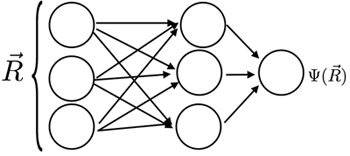 Advances in Monte Carlo Techniques for Many-Body Quantum Systems (INT-18-2b)
Advances in Monte Carlo Techniques for Many-Body Quantum Systems (INT-18-2b)(INT Program July 30 - September 7, 2018)
Reported by B.K. Clark, S. Gandolfi, F. Pederiva, M.J. Savage
Reported on October 15, 2018
Application of Monte Carlo methods to the solution of interesting problems in physics, and particularly in Quantum Theory, has a long history. The potential capability of exactly solving for eigenstates of a given Hamiltonian collides with some well-known fundamental obstacles, such as the fermion sign problem which is caused by an exponentially decaying signal to noise ratio in the simulation. Read more...
 TALENT School: Fundamental Symmetries & Neutrinos (INT-18-2c)
TALENT School: Fundamental Symmetries & Neutrinos (INT-18-2c)(INT Program July 9 - 27, 2018)
Reported by V. Cirigliano, M. Ramsey-Musolf
Reported on December 20, 2018
The school was co-organized by Vincenzo Cirigliano and Michael Ramsey-Musolf, who provided the main lectures and facilitated the problem sessions. In addition, three guest lecturers provided experimental perspectives on the main themes of the school: Jason Detwiler (neutrinos); Brad Filippone (electric dipole moments); and David Hertzog (precision tests). 22 students attended the School. Read more...
 Probing Nucleons and Nuclei in High Energy Collisions (INT-18-3)
Probing Nucleons and Nuclei in High Energy Collisions (INT-18-3)(INT Program October 1 - November 16, 2018)
Reported by Y. Hatta, Y. Kovchegov, C. Marquet, A. Prokudin
Reported on December 18, 2018
This 7-week INT workshop was dedicated to the physics of the Electron Ion Collider (EIC), the world's first polarized electron-nucleon (ep) and electron-nucleus (eA) collider to be constructed in the USA following the 2015 NSAC recommendation as the highest priority long range plan. The primary goal of the EIC is to establish the precise multidimensional imaging of quarks and gluons inside nucleons and nuclei. Read more...
2017
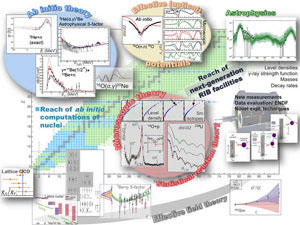 Toward Predictive Theories of Nuclear Reactions Across the Isotopic Chart (INT-17-1a)
Toward Predictive Theories of Nuclear Reactions Across the Isotopic Chart (INT-17-1a)(INT Program February 27 - March 31, 2017)
Reported by J.E. Escher, J. Blackmon, Ch. Elster, K.D. Launey, D. Lee, and N.D. Scielzo
Reported on May 16, 2017
Recent years have seen exciting new developments and progress in nuclear structure theory, reaction theory, and experimental techniques, that allow us to move towards a description of exotic systems and environments, setting the stage for new discoveries. The purpose of the 5-week program was to bring together physicists from the low-energy nuclear structure and reaction communities to identify avenues for achieving reliable and predictive descriptions of reactions involving nuclei across the isotopic chart. The 4-day embedded workshop focused on connecting theory developments to experimental advances and data needs for astrophysics and other applications. Read more...
 SIGN 2017: International Workshop on the Sign Problem in QCD and Beyond (INT-17-64W)
SIGN 2017: International Workshop on the Sign Problem in QCD and Beyond (INT-17-64W)(INT Workshop March 20 - 24, 2017)
Reported by J. Carlson, S. Chandrasekharan, K. Damle, C. Gattringer, D.B. Kaplan, U-J. Wiese
Reported on May 4, 2017
Sign problems are an important stumbling block in applying the Monte Carlo method to solve QCD at finite densities and understand nuclear matter. Sign problems also haunt several other research areas that deal with quantum many body physics, including strongly correlated electronic systems away from half filling and frustrated quantum spin models. This international conference brought together 71 physicists (45 senior researchers, 17 posdoctoral associates, 9 graduate students), interested in this broad area of research. This was the fifth in a series of conferences and the first one organized in the US. Read more...
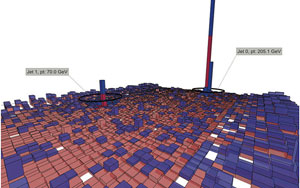 Precision Spectroscopy of QGP Properties with Jets and Heavy Quarks (INT-17-1b)
Precision Spectroscopy of QGP Properties with Jets and Heavy Quarks (INT-17-1b)(INT Program May 1 - June 8, 2017)
Reported by S. Bass, A. Majumder, J. Putschke, and L. Ruan
Reported on July 25, 2017
Data taken at the Relativistic Heavy Ion Collider (RHIC) since the year 2000 have shown conclusively that the high temperature phase of QCD matter is a quark- gluon plasma with the characteristics of a "nearly perfect" liquid. Read more...
 Neutrinoless Double-beta Decay (INT-17-2a)
Neutrinoless Double-beta Decay (INT-17-2a)(INT Program June 13 - July 14, 2017)
Reported by J. Engel, J. Carlson and V. Cirigliano
Reported on July 28, 2017
Experimental groups worldwide are working to develop detectors that may allow the observation of neutrinoless double-beta decay in isotopes such as 76Ge, 136Xe, 130Te, and 82Se. Observation would have far reaching consequences: it would prove that lepton number is violated, demonstrate that neutrinos are Majorana particles, and provide information about the neutrino-mass generation mechanism and possibly about baryogenesis. Read more...
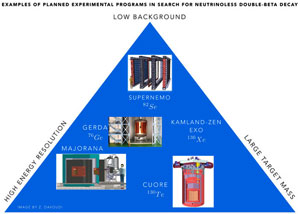 Lattice QCD Input for Neutrinoless Double-β Decay (INT-17-67W)
Lattice QCD Input for Neutrinoless Double-β Decay (INT-17-67W)(INT Workshop July 6 - 7, 2017)
Reported by Z. Davoudi, W. Detmold, A. Nicholson and M. Savage
Reported on July 26, 2017
The discovery of a neutrinoless double-β decay of a nucleus would provide unambiguous evidence of lepton-number violation in nature, and have important implications for the nature of neutrino mass. The search for such decays is a high priority of the nuclear physics community in the US, as was highlighted in the 2015 Long Range Plan for Nuclear Science. Read more...
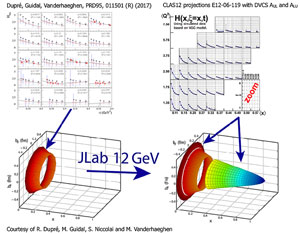 Spatial and Momentum Tomography of Hadrons and Nuclei (INT-17-3)
Spatial and Momentum Tomography of Hadrons and Nuclei (INT-17-3)(INT Program August 28 - September 29, 2017)
Reported by I. Cloët, K. Hafidi, Z-E. Meziani, B. Pasquini
Reported on November 3, 2017
The last decade or so has seen the development of a comprehensive approach to the description of hadron and nuclear structure. This framework encodes our knowledge of hadrons and nuclei in the Wigner distributions of the fundamental constituents − quarks and gluons − whose interactions are governed by quantum chromodynamics (QCD). Read more...
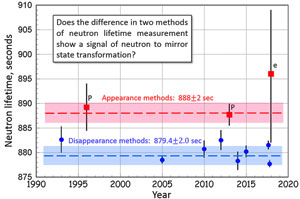 Neutron-Antineutron Oscillations: Appearance, Disappearance, and Baryogenesis (INT-17-69W)
Neutron-Antineutron Oscillations: Appearance, Disappearance, and Baryogenesis (INT-17-69W)(INT Workshop October 23 - 27, 2017)
Reported by K. Babu, Z. Berezhiani, Y. Kamyshkov, B. Kerbikov
Reported on November 15, 2017
Goal of workshop was the discussion of the current status of neutron oscillation phenomena between theory and experiment in relation with two outstanding questions of particle physics and cosmology: understanding of baryogenesis (mechanism of matter-antimatter asymmetry of universe) and understanding the nature of Dark Matter. Read more...
2016 News Items
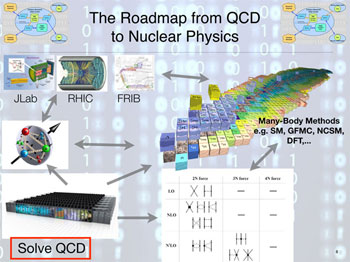 Nuclear Physics from Lattice QCD (INT-16-1)
Nuclear Physics from Lattice QCD (INT-16-1)
(INT Program March 21 - May 27, 2016)
Reported by Nir Barnea, Silas Beane, Zohreh Davoudi, Ubirajara van Kolck
Reported on July 11, 2016
The last decade has witnessed dramatic progress in three directions -- lattice quantum chromodynamics (LQCD), nuclear effective field theories (NEFT), and ab initio nuclear-structure methods (AiM) -- all of which aim to derive and describe nuclear physics with fully controlled uncertainties in a manner consistent with QCD. Read more...
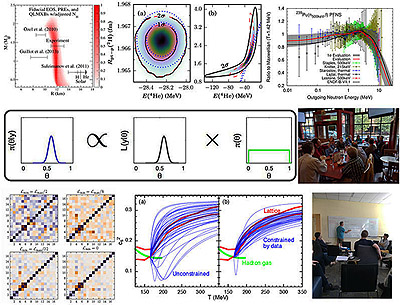 Bayesian Methods in Nuclear Physics (INT-16-2a)
Bayesian Methods in Nuclear Physics (INT-16-2a)
(INT Program June 13 - July 8, 2016)
Reported by Richard Furnstahl, Dave Higdon, Nicolas Schunck, Andrew Steiner
Reported on July 19, 2016
The INT Program INT-16-2a on "Bayesian Methods in Nuclear Physics" was held from June
13 through July 8, 2016. It had 51 registered participants and 35 scheduled talks with focused afternoon discussions. Bayesian statistics is a well-developed field, although it has not been part of the traditional education of nuclear theorists. Read more...
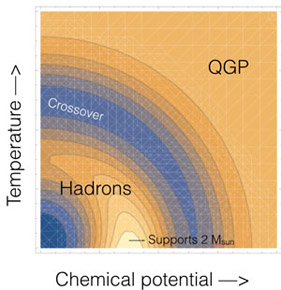 The Phases of Dense Matter (INT-16-2b)
The Phases of Dense Matter (INT-16-2b)
(INT Program July 11 - August 12, 2016)
Reported by Mark Alford, Pawel Danielewicz, Chuck Horowitz, Thomas Schaefer
Reported on September 19, 2016
One of the central aims of nuclear and particle physics is to understand the phases of matter that exist under extreme conditions of high density and/or high temperature. This program focused on inferring the properties and phase structure of dense matter from both laboratory experiments and astronomical observations. Read more...
 Flavor Observations with Supernova Neutrinos (INT-16-61W)
Flavor Observations with Supernova Neutrinos (INT-16-61W)
(INT Workshop August 15 - 19, 2016)
Reported by Chuck Horowitz, H.-Thomas Janka, Sanjay Reddy, and Kate Scholberg
Reported on August 23, 2016
Supernova (SN) neutrinos, as astrophysical messengers, carry unique flavor, time and energy information that may be crucial for understanding neutrino oscillations, the SN explosion mechanism, neutron star properties, and nucleosynthesis. Historically, about 20 electron anti-neutrinos were detected from SN 1987A. Read more...
 Spectrum and Structure of Excited Nucleons from Exclusive Electroproduction (INT-16-62W)
Spectrum and Structure of Excited Nucleons from Exclusive Electroproduction (INT-16-62W)(INT Workshop November 14 - 18, 2016)
Reported by V. D. Burkert, R. W. Gothe, V. Mokeev, C. D. Roberts, and A. Szczepaniak
Reported on May 4, 2017
Two of the most basic goals of nuclear physics are to understand the mechanisms responsible for the formation of hadrons and explain their structure in terms of the gluons and quarks of quantum chromodynamics (QCD). In this connection, measurements of the nucleon excitation (N*) spectrum and exploration of N* structure through the study of resonance electro-excitation amplitudes (γνNN* electrocouplings) on a broad domain of photon virtualities (Q2) present unique opportunities for elucidating these crucial aspects of nonperturbative strong-interaction dynamics. The complexity of this problem is great, so a multipronged approach is necessary to achieve its solution. Read more...
 Theoretical Developments in Neutrino-Nucleus Scattering (INT-16-63W)
Theoretical Developments in Neutrino-Nucleus Scattering (INT-16-63W)(INT Workshop December 5 - 9, 2016)
Reported by Bill Donnelly, Gerry Garvey, Hirohisa Tanaka, Geralyn Zeller
Reported on February 6, 2017
The study of neutrino-nucleus interactions continues to be a dynamic and critical field at the interface of nuclear and particle physics. Measurements of neutrino-nucleus scattering cross sections are driven mainly by the needs of current and future neutrino oscillation experiments which aim for unprecedented precision and sensitivity in next generation experiments. Read more...
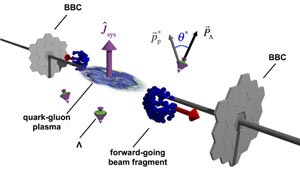 Exploring the QCD Phase Diagram through Energy Scans (INT-16-3)
Exploring the QCD Phase Diagram through Energy Scans (INT-16-3)
(INT Program September 19 - October 14, 2016)
Reported by Volker Koch, Michael Lisa, Hannah Petersen, Paul Sorensen
Reported on January 10, 2017
The goal of this program was to deepen our theoretical understanding of the phase structure of QCD-in particular the de-confinement transition and possible critical point-from present experimental programs, and to provide theoretical guidance to upcoming programs at several facilities worldwide. All talks and discussions were centered around this goal and highlighted different facets of this overarching task. Read more...
2015 News Items
 Neutrino Astrophysics and Fundamental Properties (INT-15-2a)
Neutrino Astrophysics and Fundamental Properties (INT-15-2a)
(INT Program June 1 - 26, 2015)
Reported by K. Abazajian, W. Haxton, C. Lundardini, I. Sarcevic
Reported on July 27, 2015
The extent to which astrophysical neutrinos can help us address open questions in fundamental neutrino physics, such as the absolute scale of neutrino mass and the hierarchy, on a timescale comparable to that envisioned for major terrestrial experiments, such as LBNF and LBNO. Read more...
 Frontiers in Quantum Simulation with Cold Atoms (INT-15-1)
Frontiers in Quantum Simulation with Cold Atoms (INT-15-1)
(INT Program March 23 - May 8, 2015)
Reported by I. Bloch, C. Chin, T.-L. Ho, U.-J. Wiese, P. Zoller
Reported on July 29, 2015
During the last decade, it has been realized that cold atom systems form a highly flexible platform
for simulating many important models in theoretical physics. Traditionally, these models are results of abstractions or idealizations of various physical situations. Read more...
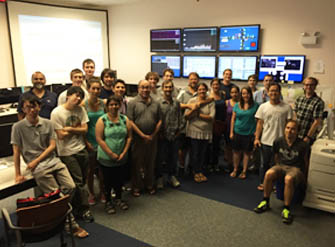 INT TALENT 2015: Nuclear Physics of Neutron Stars and Supernovae (INT-15-59W)
INT TALENT 2015: Nuclear Physics of Neutron Stars and Supernovae (INT-15-59W)
(INT Program June 22- July 10, 2015)
Reported by C.J. Horowitz, S. Reddy
Reported on August 3, 2015
The lectures were aimed at providing the theoretical basis needed to describe neutron rich
dense matter and its role in neutron stars and supernova. A significant component of the
course was also devoted to describing strategies to probe neutron rich matter with laboratory experiments and astronomical observations with photons, neutrinos, and gravitational waves. Read more...
 Equilibration Mechanisms in Weakly and Strongly Coupled Quantum Field Theory
Equilibration Mechanisms in Weakly and Strongly Coupled Quantum Field Theory (INT-15-2c)
(INT Program August 3 - 28, 2015)
Reported by Jorge Casalderrey Solana, Francois Gelis, Aleksi Kurkela, Aleksi Vuorinen
Reported on September 28, 2015
The out-of-equilibrium dynamics of systems described by quantum field theory is a notoriously complicated topic that has witnessed a renewed interest during the past decade. Although
this has mostly stemmed from the physics of heavy ion collisions, further applications to systems ranging from the reheating of the early universe to quantum quenches in condensed matter systems have been widely discussed as well. Read more...
 Modern Exotic Hadrons (INT-15-60W)
Modern Exotic Hadrons (INT-15-60W)
(INT Workshop November 2-13, 2015)
Reported by Jozef Dudek, Ryan Mitchell, Eric Swanson
Reported on November 23, 2015
The workshop "Modern Hadronic Hadrons" brought together 25 experts in the field of hadron spectroscopy
to assess the multitude of novel states that has been discovered in the past eleven years. Several of these states point to new ways in which Quantum Chromodynamics can construct matter. Read more...
 Intersections of BSM Phenomenology and QCD for New Physics Searches (INT-15-3)
Intersections of BSM Phenomenology and QCD for New Physics Searches (INT-15-3)
(INT Program September 14 - October 23, 2015)
Reported by Susan Gardner, Huey-Wen Lin, Felipe J. Llanes-Estrada, Ruth Van de Water
Reported on December 7, 2015
The main purpose of the six-week program was to bring together theorists from the nuclear- and particle-physics communities to address key issues in the assessment of the QCD inputs needed to realize the next generation of low-energy precision experiments, with the end of identifying possible physics beyond the Standard Model. Such new-physics searches span a range of physics subfields, and we organized our program into themes that would collect them. Read more...
2014 News Items
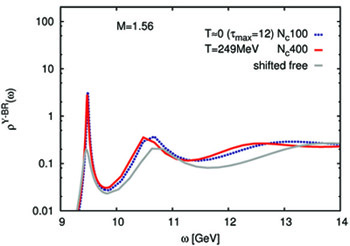 Heavy Flavor and Electromagnetic Probes in Heavy Ion Collisions (INT-14-3)
Heavy Flavor and Electromagnetic Probes in Heavy Ion Collisions (INT-14-3)
(INT Program September 15 - October 10, 2014)
Reported by A.D. Frawley, P. Petreczky, E. Scomparin, R. Vogt
Reported on November 13, 2014
The Institute for Nuclear Theory program, Heavy Flavor and Electromagnetic Probes in Heavy-Ion Collisions (INT 14-3), was held 15 September to 10 October 2014. In addition to the four organizers: Ramona Vogt (LLNL and UC Davis), Peter Petreczky (BNL), Anthony Frawley (Florida State), and Enrico Scomparin (INFN Torino), the program was attended by 34 other participants spread out over the four week period. Read more...
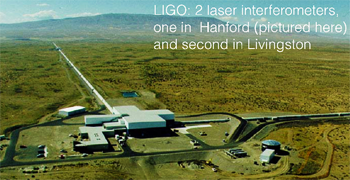 Binary Neutron Star Coalescence as a Fundamental Physics Laboratory (INT-14-2a)
Binary Neutron Star Coalescence as a Fundamental Physics Laboratory (INT-14-2a)
(INT Program June 30 - July 25, 2014)
Reported by N. Andersson, S. Bose, S. Reddy, L. Rezzolla
Reported on November 20, 2014
Advanced LIGO (Laser Interferometer Gravitational-Wave Observatory) is expected to
increase the existing detector sensitivity ten-fold the sensitivity by 2016-2017. This would
allow us to detect Gravitational Waves (GWs) from neutron star mergers out to about 200
Mpc and open a new window to the universe.
Read more...
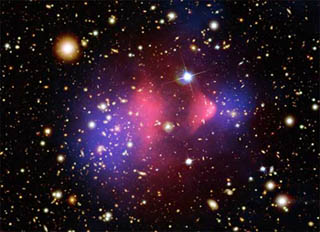 Nuclear Aspects of Dark Matter Searches (INT-14-57W)
Nuclear Aspects of Dark Matter Searches (INT-14-57W)
(INT Workshop December 8-12, 2014)
Reported by M. Buchoff, W. Haxton, G. Kribs
Reported on July 1, 2015
The INT workshop "Nuclear Aspects of Dark Matter Searches" (14-57W) was a one week workshop held December 8-12, 2014, which brought together physicists from very diverse backgrounds including nuclear theory (about 40%), particle theory (about 40%), and dark matter experiments (about 20%).
Read more...
2013 News Items
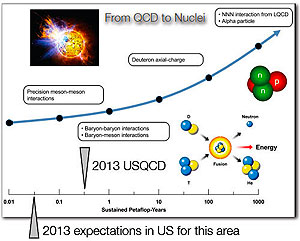 Nuclear Reactions from Lattice QCD
Nuclear Reactions from Lattice QCD
(INT Workshop March 11-12, 2013)
Reported by R. Briceno, Z. Davoudi, T. Luu
Date posted April 9, 2013
Lattice quantum chromodynamics (LQCD), as the only truly ab inito approach for studying hadronic systems, has recently started to address long-standing problems in nuclear physics. Studying nuclear reactions directly from LQCD is the most recent quest in this direction, and amongst the most challenging ones as well. Read more...
 Computational and Theoretical Advances for Exotic Isotopes
in the Medium Mass Region
Computational and Theoretical Advances for Exotic Isotopes
in the Medium Mass Region
(INT Program March 25 - April 19, 2013)
Reported by C. Barbieri, T. Duguet, G. Hagen, and S. Bogner
Reported on July 9, 2013
Low energy nuclear physics is currently going through an unprecedented revival due to several combining factors. Explicit links with the underlying Quantum Chromo Dynamics have allowed to developed models of the nuclear interaction soft enough to converge in quantum many-body calculations, say up to A=100 nucleons. Read more...
 Quantum Noise in Nuclear and Condensed Matter Physics
Quantum Noise in Nuclear and Condensed Matter Physics
(INT Program May 6 - 31, 2013)
Reported by A. Andreev, L. Glazman, and D.B. Kaplan
Reported on July 30, 2013
Quantum fluctuations or "noise" are ubiquitous. Though treated as random in statistical approaches, fluctuations often arise from dynamical correlations between the underlying degrees of freedom of the physical system. In some situations noise complicates obtaining the information of interest from an experiment or a numerical simulation. Read more...
 Advances in Quantum Monte Carlo Techniques for Non-Relativistic Many-Body Systems
Advances in Quantum Monte Carlo Techniques for Non-Relativistic Many-Body Systems
(INT Program June 24th - August 2nd, 2013)
Reported by F. Arias de Saavedra, J. E. Drut, J. L. DuBois, S. Gandolfi, F. Pederiva
Reported on August 28, 2013
Whenever a reliable, first-principles understanding of a many-body quantum mechanical problem is required, Monte Carlo methods are needed. Read more...
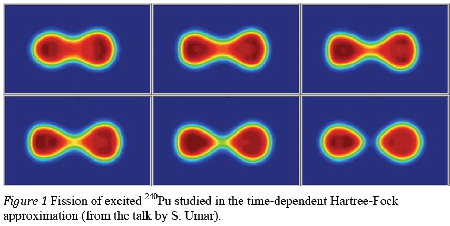 Quantitative Large Amplitude Shape Dynamics: fission and heavy ion fusion
Quantitative Large Amplitude Shape Dynamics: fission and heavy ion fusion
(INT Program September 23 - November 15, 2013)
Reported by A.N. Andreyev, G.F. Bertsch, W. Loveland, W. Nazarewicz
Reported on November 15, 2013
The intent of this program was to: (i) bring together theorists working on predictive theories of the underlying shape dynamics to compare various approaches and computational methodologies; (ii) actively foster collaborations between the major actors in the field, including collaborations between experiment and theory; (iii) identify critical experimental data that will inform theoretical developments; and (iv) identify strategies and resources to break computational barriers in this area. Read more...
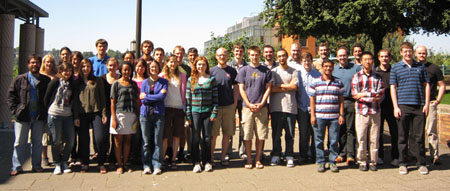 TALENT/INT Course on Nuclear forces and their impact on structure, reactions, and astrophysics
TALENT/INT Course on Nuclear forces and their impact on structure, reactions, and astrophysics
(INT Program July 1-19, 2013)
Reported by Dick Furnstahl and Achim Schwenk
Reported on November 21, 2013
The course covered modern theoretical approaches to nuclear forces, including pionless and chiral effective field theory, renormalization group methods, and connections to QCD. Read more...
2012 News Items
 Gauge Field Dynamics In and Out of Equilibrium
Gauge Field Dynamics In and Out of Equilibrium
(INT Program July 30 - August 31, 2012)
Reported by G. Aarts, G.D. Moore, M. Laine
Reported on April 20, 2012
The many-body physics of relativistic non-Abelian gauge theories plays an important role in current heavy ion collision experiments, in the astrophysics
of compact stars, as well as in cosmology. Read more...
 Orbital Angular Momentum in QCD
Orbital Angular Momentum in QCD
(INT Workshop February 6 - 17, 2012)
Reported by L. Bland, Z.E. Meziani, G.A. Miller, M. Vanderhaeghen, C. Weiss, F. Yuan
Reported on July 31, 2012
Angular momentum has emerged as a key issue in the quest to understand the internal structure of hadrons on the basis of the fundamental theory of strong interactions, Quantum Chromodynamics (QCD). How does the nucleon's spin arise from the interacting quark and gluon fields or their particle-like quanta? Read more...
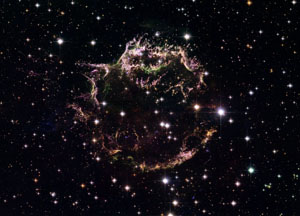 Core-Collapse Supernovae: Models and Obserable Signals
Core-Collapse Supernovae: Models and Obserable Signals
(INT Program June 25 - July 27, 2012)
Reported by C. Cardall, H-T. Janka, J. Lattimer, J. Murphy
Reported on August 9, 2012
Core-collapse supernovae are among the most energetic explosions in the Universe. As such they
play a major role in many astrophysical phenomena, including galactic dynamics, nucleosynthesis,
and neutron star and black hole formation. Read more...
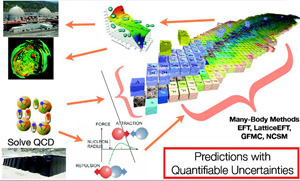 Lattice QCD Studies of Excited Resonances and Multi-Hadron Systems
Lattice QCD Studies of Excited Resonances and Multi-Hadron Systems
(INT Program July 30 - August 31, 2012)
Reported by Silas Beane and Colin Morningstar
Reported on November 26, 2012
The calculation of properties of excited baryon and meson resonances, exotic states, and multi-hadron systems using lattice QCD has only recently become possible due to advances in high-performance computing supplemented by novel methodologies and algorithmic developments. Read more...
2011 News Items
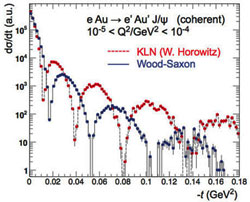 Gluons and the Quark Sea: Distributions, polarization, tomography
Gluons and the Quark Sea: Distributions, polarization, tomography(INT Program September 13 to November 19, 2010)
Reported by Daniel Boer, Markus Diehl, Richard Milner, Raju Venugopalan, Werner Vogelsang
Reported on May 18, 2011
The INT program on Gluons and the Quark Sea addressed outstanding open questions in our understanding of the partonic sub-structure of hadrons and nuclei at high energies. Despite much progress, basic questions of fundamental interest are either unresolved or have a significant degree of ambiguity in their interpretation. Read more...
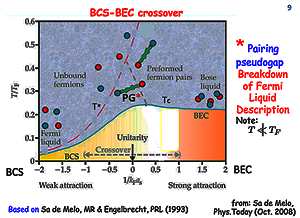 Fermions from Cold Atoms to Neutron Stars: Benchmarking the Many-Body Problem
Fermions from Cold Atoms to Neutron Stars: Benchmarking the Many-Body Problem(INT Program March 14 - May 20, 2011)
Reported by Michael McNeil Forbes, Aurel Bulgac, Alexandros Gezerlis, Gorva V. Shlyapnikov, Tin-Lun (Jason) Hu, Martin W. Zwierlein
Reported on September 20, 2011
Fermionic many-body theory lies at the heart of many physical systems, from cold atoms through superconductors and superfluids to nuclear matter and dense QCD, yet concrete and reliable results are difficult to obtain, even for the simplest systems. Read more...
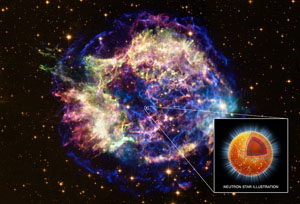 Multi-Messenger Probes of Nuclear Physics
Multi-Messenger Probes of Nuclear Physics(INT Program July 11 - August 5, 2011)
Reported by B. Link, E. F. Brown, C. L. Fryer, S. Reddy
Reported on September 21, 2011
In the coming decade, science for the first time may witness transient astrophysical events,
such as the explosion of a massive star, not only across a wide swath of the electromagnetic
spectrum, but also in neutrinos and gravitational waves. Read more...
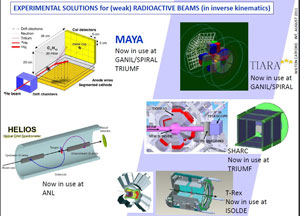 Interfaces between Structure and Reactions for Rare Isotopes and Nuclear Astrophysics
Interfaces between Structure and Reactions for Rare Isotopes and Nuclear Astrophysics(INT Workshop August 8 - September 2, 2011)
Reported by B. A. Brown (chair), H. Esbensen, P. Danielewicz, J.A. Tostevin
Reported on November 18, 2011
The goal of this INT Program was to identify those problems in the area of theory for reactions with rare isotopes that need to be solved in order to plan experiments for FRIB (the Facility for Rare Isotopes) and in order to understand the experimental results in terms of nuclear structure and applications to nuclear astrophysics.. Read more...
 Extreme Computing and its Implications for the Nuclear Physics/Applied
Extreme Computing and its Implications for the Nuclear Physics/AppliedMathematics/Computer Science Interface
(INT Program June 6 - July 8, 2011)
Reported by W. C. Haxton; Organizing Committee: Joe Carlson, George Fuller, Tom Luu, Juan Meza, Tony Mezzacappa, John Negele, Esmond Ng, Steve Pieper, Martin Savage, James Vary, Pavlos Vranas
Reported on December 8, 2011
The program was organized with the goal of keeping the nuclear physics community an active participant in planning for exascale computing. The field has several important applications that are computationally limited, including lattice QCD; various ab initio
nuclear structure methods (diagonalization of large sparse
shell-model matrices, ... Read more...
2010 News Items
 The Jefferson Laboratory Upgrade to 12 GeV
The Jefferson Laboratory Upgrade to 12 GeV(INT program September 14 - October 16 &
October 26 - November 20, 2009)
Reported by Carlos Munoz Camacho,Rolf Ent,Jerry Miller, and Tony Thomas
Reported on February 12, 2010
The immediate goal was to bring experimentalists and theorists together to explore and develop important aspects of the exciting physics possibilities. This goal was well achieved, as the program brought together a wide variety of about 100 experimentalists and theorists (almost 50% experimentalists) to work together during the nine-weeks of the program. Read more...
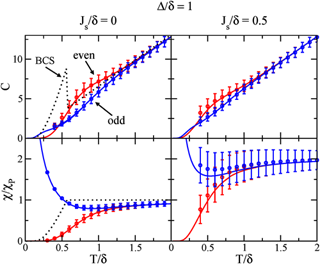 From Femtoscience to Nanoscience: Nuclei, Quantum Dots and Nanostructuress
From Femtoscience to Nanoscience: Nuclei, Quantum Dots and Nanostructuress(INT program July 20 - August 28, 2009)
Reported by Y. Alhassid, B.L. Altshuler, and V.I. Fal'ko
Reported on March 15, 2010
The program was interdisciplinary in nature and brought together the nuclear and condensed matter communities. Its main focus was on correlation effects in finite-size quantum systems such as nuclei, quantum dots and nanostructures. Read more...
 New applications of the renormalization group method in nuclear, particle and condensed matter physics
New applications of the renormalization group method in nuclear, particle and condensed matter physics(INT workshop February 22-26, 2010)
Reported by Mike Birse, Yannick Meurice, and Shan-Wen Tsai
Reported on April 12, 2010
The ideas of the renormalization group (RG) and scale invariance have played central roles in physics and are associated with the emergence of key concepts such as universality, self-similarity, scaling and asymptotic freedom. Read more...
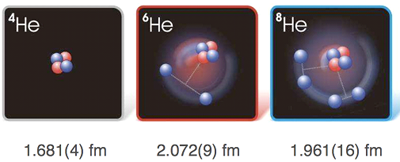 Simulations and Symmetries: Cold Atoms, QCD, and
Few-hadron Systems
Simulations and Symmetries: Cold Atoms, QCD, and
Few-hadron Systems(INT program March 15 - May 21, 2010)
Reported by Daniel Phillips, Hans-Werner Hammer, Martin Savage
Reported on August 9, 2010
Rapid advances in the experimental study of systems of cold atoms have provided controlled environments in which to explore quantum many-body dynamics. In particular, the ability to trap atoms, and dictate the strength of their interaction through Feshbach resonances, has provided a laboratory with which to investigate the consequences of varying scattering lengths all the way from the range of the atom-atom interaction to infinity. Read more...
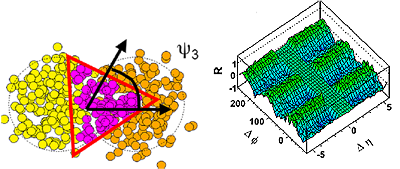 Quantifying the Properties of Hot QCD Matter
Quantifying the Properties of Hot QCD Matter(INT Program May 24 - July 16, 2010)
Reported by Brian Cole, Ulrich Heinz, Peter Jacobs, Yuri Kovchegov, Berndt Mueller, Jamie Nagle
Reported on September 16, 2010
The program on Quantifying the Properties of Hot QCD Matter was held at the INT from May 24 to July 16, 2010. The goal of the program was to bring theorists and experimentalists together to assess the results of the experimental heavy ion physics program at RHIC in the light of state-of-the-art models of relativistic heavy ion collisions, the dynamics of hot QCD matter, and of the interactions of hard probes with the hot medium. Read more...
 Long-Baseline Neutrino Physics and Astrophysics
Long-Baseline Neutrino Physics and Astrophysics(INT Program July 26 - August 27, 2010)
Reported by Wick Haxton, Boris Kayser, Bill Marciano, Aldo Serenelli
Reported on November 1, 2010
The program on Long-Baseline Neutrino Physics and Astrophysics focused on the unresolved questions in neutrino physics and their implications for astrophysics. While we now know that neutrinos are massive and that the mass eigenstates are distinct from the flavor eigenstates, many associated properties are not yet determined. Read more...
2009 News Items
 Low Energy Precision Electroweak Physics in the LHC Era
Low Energy Precision Electroweak Physics in the LHC Era(INT Program September 22 - December 5, 2008)
Reported by V. Cirigliano, J. Erler, K. S. Kumar , M. J. Ramsey-Musolf
Reported on March 19, 2009
Our current understanding of the fundamental constituents of matter and their interactions (except for gravity) is encoded in the so-called Standard Model (SM) of strong and electroweak interactions. The SM describes the interactions among matter constituents (quark and leptons) mostly in terms of the exchange of spin-1 force carriers (gauge bosons). Read more...
 Solar Fusion Cross Sections for the pp Chain
and CNO Cycle
Solar Fusion Cross Sections for the pp Chain
and CNO Cycle(INT Workshop January 21 - 23, 2009)
Reported by W. Haxton
Reported on April 7, 2009
The 21-23 January 2009 workshop brought together 42 participants - experimentalists and theorists - to consider the nuclear microphysics important to the standard solar model and to red giants. Read more...
 New frontiers in large N gauge theories
New frontiers in large N gauge theories(INT Workshop February 3 - 6, 2009)
Reported by Barak Bringoltz
Reported on June 5, 2009
The workshop succeeded in bringing together physicists from different communities: large N phenomenology, lattice gauge theory, formal QFT, and AdS/CFT, to explore topics of joint interest. Read more...
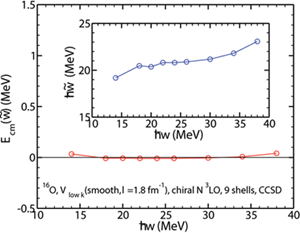 Effective Field Theories and the Many-Body Problem
Effective Field Theories and the Many-Body Problem(INT program March 23 - June 5, 2009)
Reported by Calvin Johnson, Dick Furnstahl, Erich Ormand, and Bira van Kolck
Reported on July 28, 2009
The program on Effective Field Theories and the Many-body problem was held at the INT from
March 23 through June 5, 2009. We had close to
90 participants and 54 talks. Read more...
 Joint CATHIE-INT mini-program: Quarkonium in Hot Media - from QCD to Experiment
Joint CATHIE-INT mini-program: Quarkonium in Hot Media - from QCD to Experiment(INT program June 16 - 26, 2009)
Reported by Nora Brambilla, Dmitri Kharzeev, Peter Petreczky, Helmut Satz, Antonio Vairo, and Ramona Vogt
Reported on August 3, 2009
The mini program "Quarkonium in Hot Media: from QCD to Experiment" was held at the INT in Seattle on June 16-26, 2009 with 32 participating researchers. Read more...
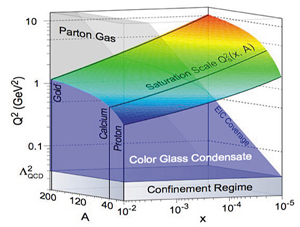 INT workshop on Physics at a High Energy Electron Ion Collider
INT workshop on Physics at a High Energy Electron Ion Collider(INT workshop October 19 - 23, 2009)
Reported by Daniel Boer, Markus Diehl, Raju Venugopalan, and Werner Vogelsang
Reported on December 21, 2009
The goal of the INT workshop on Physics at a High Energy Electron Ion Collider was to explore the physics case for an Electron Ion Collider (EIC), A "medium energy" proposal for the collider would provide high luminosity collisions (1033/cm2/sec or greater) of 4 to 5 GeV electron beams on polarized proton beams with energies ranging from 60 to 250 GeV and light and heavy nuclei with energies up to 100 GeV/nucleon. Read more...
2008 News Items
 The Flip Side of Femtoscopy
The Flip Side of Femtoscopy(A personal perspective)
Reported by Rick Casten
Reported on February 29, 2008
By far, the most common approaches today to understanding the structure of atomic nuclei are femtoscopic, by which is meant approaches focused at the nucleonic level, whether these be ab initio calculations, no-core shell model methods, large-basis shell model calculations, perhaps using Monte Carlo techniques, density functional theory (DFT) methods, or similar approaches. Read more...
Nuclear Interactions at Ultra-high Energy in Light of Recent Results from Auger
(INT workshop Feb. 20 - 22, 2008)
Reported by Larry McLerran
Reported on May 12, 2008
The Auger cosmic ray experiment is designed to measure the properties of the highest energy cosmic rays, up to 1021 eV, corresponding to a center of mass energy of 103 TeV. This is two orders of magnitude higher than the energy of pp collisions which will soon be measured in the CERN LHC experiments. Read more...
Soft photons and light nuclei
(INT workshop June 16 - 20, 2008)
Reported by Daniel Phillips, Walter Gloeckle, Haiyan Gao, and Al Nathan
Reported on July 9, 2008
About 40 theoreticians and experimentalists attended the INT workshop (co-sponsored by the Triangle Universities Nuclear Laboratory (TUNL) and the University of Illinois at Urbana-Champaign) on "Soft photons and light nuclei" at the INT from June 16-20, 2008. This meeting focused on theoretical and experimental work pertaining to photo-induced reactions on protons, neutrons, and few-body nuclei at energies below the pion threshold. Read more...
From Strings to Things
(INT program March 24 - June 6, 2008)
Reported by Dam T. Son, Misha Stephanov, Matthew Strassler, and Derek Teaney
Reported on July 28, 2008
The quest for understanding strong interactions has a long history. The challenge to construct a fundamental theory of the interactions which bind together protons and neutrons in atomic nuclei, and which are responsible for hundreds of hadronic resonances, led to the advent and development of theoretical methods which later found applications in many fields of physics.. Read more...
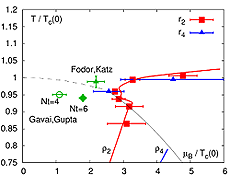 The QCD critical point
The QCD critical point(INT program July 28 - August 22, 2008)
Reported by Reported by Volker Koch, Gunther Roland, and Misha Stephanov
Reported on November 12, 2008
The QCD phase diagram is a map showing what equilibrium state strongly interacting matter would assume at given temperature and baryon density. The nature of the different phases and the location of the phase boundaries have been intriguing questions for many years. Read more...
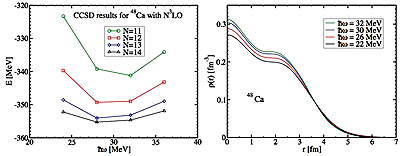 Atomic, Chemical, and Nuclear Developments in Coupled Cluster Methods
Atomic, Chemical, and Nuclear Developments in Coupled Cluster Methods(INT program June 23 - July 25, 2008)
Reported by Rod Bartlett, David Dean, Walter Johnson, and Achim Schwenk
Reported on December 2, 2008
Today, Coupled Cluster (CC) theory is widely recognized as often offering the most accurate description available for a wealth of important problems in physics and chemistry, ranging from the structure of nuclei, to relativistic CC theory of atoms, to spectra and properties of molecules. Read more...
2007 News Items

 Two-photon exchange and the proton form factor puzzle
Two-photon exchange and the proton form factor puzzleReported by Wally Melnitchouk
Reported on March 16, 2007
The proton's electromagnetic form factors are one of the most basic observables which characterize the proton's finite spatial extent. One may have thought that with over half a century of measurements we would know pretty much all that there is to know about the proton's charge and magnetic form factors, at least in the kinematics accessible to experiment. Read more...
 Quarks, gluons and nuclear forces
Quarks, gluons and nuclear forcesReported by Paulo Bedaque
Reported on August 31, 2007
When students are first told about the fundamental forces of the Universe, the strong nuclear force is described as the force binding protons and neutrons together inside nuclei. Read more...